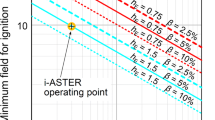Abstract
Studies have been performed to explore various plasma burn scenarios for a tokamak test reactor which could follow the next generation of large tokamak experiments. Tradeoffs between an ignited burning plasma and a sub-ignited driven plasma are examined in terms of device size and performance as a fusion engineering test facility. It is found that plasma performance levels, measured by ignition margin, amplification factorQ, and fusion power output, increase with device size, more optimistic transport scaling laws, lower magnetic field ripple, and higherΒ. The performance of a generally low stress (B 0=4 T) reference device, with major radiusR=4.5 m and minor radiusa=1.3 m in a D-shaped (κ=1.6) plasma has been evaluated over a wide range of operating parameters. In particular, a moderate fusion power output of 300 MW is obtained, the driven plasma havingQ≅ 10, an edge ripple of 1%, and a density ranging between 1.0 and 1.5×1014 cm−3. The same device operated at a higher general level of stress (B 0=5.3 T) is predicted to achieve ignition, but is not required for the mission of an engineering test facility and would entail greater technical risk.
Similar content being viewed by others
References
D. L. Jassby,Nucl. Fusion 17:309 (1977).
ETF Design Center Team, Mission Statement for the Engineering Test Facility, Oak Ridge National Laboratory Report, ORNL/TM-6732 (1979).
ETF Design Center, ETF interim design description document, Rockville, Md. (July, 1980).
W. M. Stacey, Jr., et al., US contribution to the International Tokamak Reactor Workshop, USA INTOR/PHY/80-15 (1980).
M. Murakami, J. D. Callen, and L. A. Berry,Nucl. Fusion 16:347 (1976).
J. Dawson, H. Furth, and F. Tenney,Phys. Rev. Lett. 26:1156 (1971).
H. Furth, Princeton Plasma Physics Laboratory, Presentation at DOE Review Meeting on D-T Experiments, Washington, D.C. (1973).
D. L. Jassby,Nucl. Fusion 15:453 (1975).
J. G. Cordey, W. G. F. Core, and J. Sheffield,Nucl. Fusion 15:755 (1975).
R. W. Conn and J. Kesner,Nucl. Fusion 15:775 (1975).
J. Dawson and A. Lin, Some new ideas on wet wood burners, University of California-Los Angeles Report PPG-218 (1975).
R. W. Conn and D. L. Jassby, A tokamak engineering test reactor, Princeton Plasma Physics Laboratory Report MATT-1115 (1975).
B. Badger, et al., TETR-A tokamak engineering test reactor to qualify materials and blanket components for early DT fusion power reactors, University of Wisconsin Fusion Research Program Report UWFDM-191 (1977).
J. G. Cordey, Lecture course on theory of magnetically confined plasmas, Varenna (1977).
J. F. Clarke,Nucl. Fusion 20:563 (1980).
L. Bromberg and D. R. Cohn, Passive thermal stability in ignited tokamaks by ripple transport and radial motion, MIT Plasma Fusion Center Report PFC/RR-79-19-R (1980).
B. Brunnelli, ed.,Proceedings of the Course, Driven Magnetic Fusion Reactors (Price-Trapani, Italy; Pergamon Press, Oxford, 1979).
D. L. Jassby, D. R. Cohn, and R. R. Parker,Nucl. Fusion 16:1045 (1976). A. Gondhalekar et al., inPlasma Physics and Controlled Nuclear Fusion Research (Proc. 7th Int. Conf., Innsbruck, 1978), Vol. 1 (IAEA, Vienna, 1979), p. 211.
B. Coppi and E. Mazzucato,Phys. Lett. 71A:337 (1979).
K. Molvig, S. P. Hirshman, and J. C. Whitson,Phys. Rev. Lett. 43:582 (1979).
P. H. Rutherford, Princeton Plasma Physics Laboratory, ETF interim design review, Rockville, Md. (July, 1980).
T. E. Stringer,Nucl. Fusion 12:289 (1972). J. W. Connor and R. J. Hastie,Nucl. Fusion 13:221 (1973).
N. A. Uckan, K. T. Tsang, and J. D. Callen, Effects of the poloidal variation of the magnetic field ripple on enhanced heat transport in tokamaks, Oak Ridge National Laboratory Report ORNL/TM-5438 (1976). F. P. G. Scidl et al., US contribution to the International Tokamak Reactor Workshop, Chap. VI.6, USA INTOR/PHY/80-15 (June 1980).
A. H. Boozer, Enhanced transport in tokamaks due to toroidal ripple, Princeton Plasma Physics Laboratory Report PPPL-1619 (1980).
N. A. Uckan, T. Uckan, and J. R. Moore, Calculation of magnetic field ripple effects in circular and noncircular tokamaks, Oak Ridge National Laboratory Report ORNL/TM-5603.
J. E. Scharer, R. W. Conn, and D. T. Blackfield, Study of fast magnetosonic wave and neutral beam heating of large tokamaks, Electric Power Research Institute Topical Report EPRI-268 (1976).
J. E. Scharer, J. B. Beyer, D. T. Blackfield, and T. K. Mau,Nucl. Fusion 19:1171 (1979), and references cited therein.
D. T. Blackfield, Numerical simulations of ICRF heated tokamak plasmas, University of Wisconsin Fusion Research Program Report UWFDM-353 (1980).
B. D. McVey,Nucl. Fusion 19:461 (1979). B. D. McVey, A ray tracing analysis of fast wave heating of tokamaks, Ph.D. thesis, University of Wisconsin (1978).
See, for example, D. F. Düchs, D. E. Post, and P. H. Rutherford,Nucl. Fusion 17:3 (1977). M. P. Hacker, ZEROD—a zero dimensional, time dependent tokamak plasma simulation code for reactor scoping studies, General Atomic Company Report GA-A15327 (1980). Ref. 9 in this paper.
W. A. Houlberg, H. C. Howe, and S. E. Attenberger, Deuterium and tritium fueling in an ETF/INTOR plasma with divertor, Oak Ridge National Laboratory Report ORNL/TM-7124 (1980).
W. A. Houlberg and R. W. Conn,Nucl. Sci. Eng. 64:141 (1977).
C. E. Singer, Updated 1-D simulations of 2.5 MA TFTR D-T discharges (3–6 Beamlines ± Impurities), Princeton Plasma Physics Laboratory TFTR Physics Group Report #22 (1980).
A. H. Boozer, Princeton Plasma Physics Laboratory, private communication.
Y.-K. M. Peng and R. L. Reid, A preliminary assessment of low-cost ETF (FED), ETF Design Center Internal Memo ETF-R-80-PS-027 (1980).
Fusion Engineering Design Center, Oak Ridge National Laboratory (May 1981).
D. A. D'lppolito, G. L. Francis, J. R. Myra, and W. M. Tang,Phys. Fluids 24:2270 (1981).
G. W. Shuy and R. W. Conn, Charged particle cross section requirements for advanced fusion fuel cycle analysis, Proc. Int. Conf. Nuclear Cross Sections for Technology, Knoxville, Tenn. (November 1979).
Author information
Authors and Affiliations
Rights and permissions
About this article
Cite this article
Mau, T.K., Conn, R.W. Exploratory studies of tokamaks as fusion test reactors. J Fusion Energ 2, 207–224 (1982). https://doi.org/10.1007/BF01050932
Received:
Issue Date:
DOI: https://doi.org/10.1007/BF01050932




